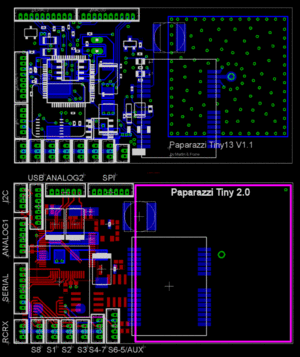Future Autopilots
Tiny 2.0 is in development!
Antoine began a complete re-reouting of the Tiny autopilot on November 2, 2006. The new design is not a bug-fix as no known flaws exist with the current 0.99 and 1.1 versions, so the redesign is purely performance-oriented! Download the Eagle files
Planned feature additions
- Hardware flow control on the modem
- The LPC has one "full-featured" serial port and one basic serial port. Current versions have the full-featured port hard-wired to the GPS in order to leave the basic port open for initial bootloader programming. Tiny 2.0 will exchange these ports and add test points to disconnect the GPS for the one-time bootloader programming.
- TI PTH08080WAS switching 5V/2.25A regulator
- This integrated power supply will greatly simplify manufacturing, reduce costs, and improve performance. Tiny 2.0 will have a voltage input range of 6-16V and enough 5V power for large servos and high-power modems and video systems.
- Larger GPS ground plane and antenna
- The 13mm antenna on Tiny 1.1 proved to be an unworthy exchange of performance for weight. Crude parking-lot tests showed an approximate 3dBi loss (as expected from the data sheets), but the narrow bandwidth of the small antenna made it more sensitive to de-tuning from nearby components in the aircraft. Flight performance was acceptable but poor climb rate calculations were observed with the smaller antenna. Tiny 1.1 users are advised to fit a 20mm antenna. Tiny 2.0 will use a 20mm x 4mm or 18mm x 4mm antenna and will feature 35% more ground plane area.
- Connector changes
- Tiny 2.0 will feature revised header layouts on all peripherals. The modem header will have CTS/RTS and both 5V and 3V supplies (3V is shared with LPC and ADC channels - use with caution and only with very low power modems like the 10mW Xbee).
- The button will be removed and it's function will be combined on the USB header along with an LED trigger so that indicator, button, and USB can be remotely mounted.
- Separate GPS Option
- To provide more flexible airframe installation, EMI trouble resolution, and GPS hardware optimization, a second version of Tiny 2.0 will be created with no GPS receiver or antenna. This model will feature a 4-pin serial port to connect to the external GPS and will not require test points
Proposed additions
We're always looking for great ideas. If you'd like to see something added or changed on Tiny 2.0 list it here! Please keep your suggestions relevant to this revision and post other requests in the Hardware Wish List.
- EMI filters on ADC channels
- Analog sensors are severely affected by video and modem RF. We typically see ADC reading fluctuations of +/-0.5% in a well shielded installation, but a misbehaving video transmitter or a noisy Radiotronix modem can affect ADC channels by more than 50% in the same well shielded installation. The addition of effective filters to the ADC inputs should greatly reduce the effects of RFI and allow for a much broader range of RF equipment and airframe configurations.
- I suggest the On Semiconductor NUF4220MNT1G. A 2mm x 2mm chip that filters 4 analog signals, attenuatiing RF frequencies above 16 Mhz but particularly the 800 Mhz to 5 Ghz range. (Jeremy)
- NUF4220MN is a 4 line LC EMI filter array designed for audio applications. It offers greater than -30 dB attenuation at frequencies from 800 MHz to 5.0 GHz, with no line loss. This part is a single chip solution for audio interface applications, 2 speaker lines with a microphone line. This device also offers ESD protection-clamping transients from static discharges and ESD protection is provided across all capacitors.
- Decoupling capacitor on GPS antenna
- The u-blox reference design calls for a 47pF 10% 0603 capacitor in series between the receiver and antenna. I have no idea why this is useful but apparently it must be, because this technique is commonly seen on WiFi cards, video transmitters, modems, even R/C receivers. Maybe we're missing out on something great? (Jeremy)
- Power plug
- Most users agree that the 1.25mm Molex is inadequate for the 8-16V / 1-2A main power input. The obsolete Lite board used a 4-pin 1.25mm molex to address this issue but it was akward to connect two pairs of tiny 26AWG wire to the large main-power wires. Tiny 0.9 used a "Futaba/Hitec" style header for battery input - the idea was that you could simply modify your ESC moving the 5V wire over to the battery input terminal. This solution occupied a lot of space on the Tiny and the modified ESC could easily end up mistakenly connected to standard r/c equipment. Tiny 2.0 is currently slated to have large solder pads on the input capacitors that users can solder their own wires to. Please post suggestions for a "better" method, if one exists.

